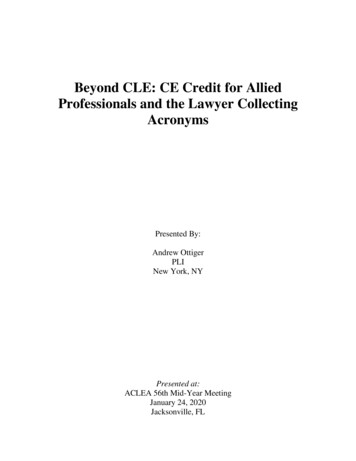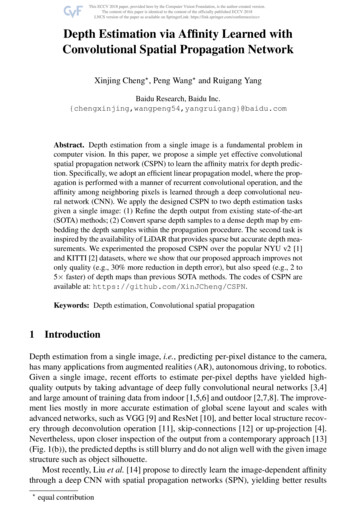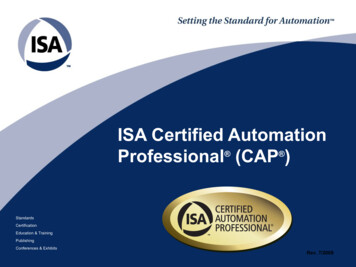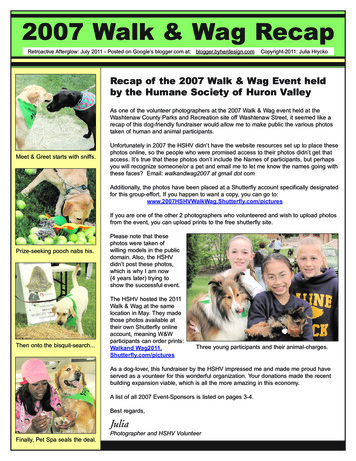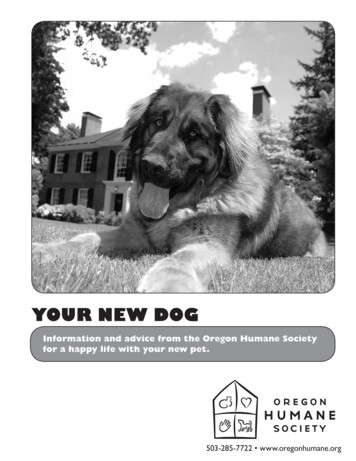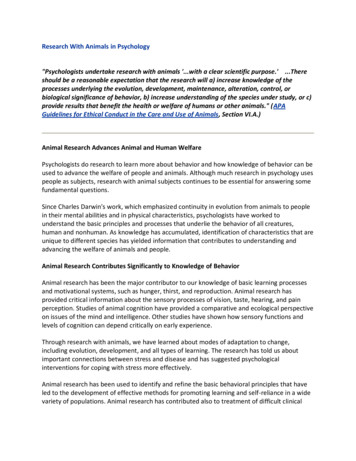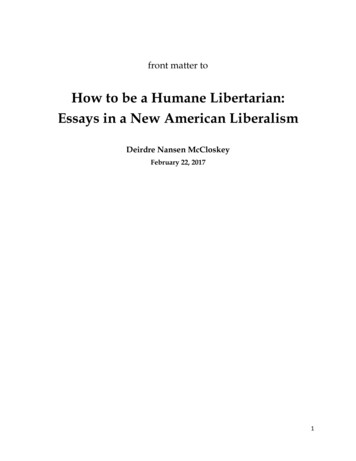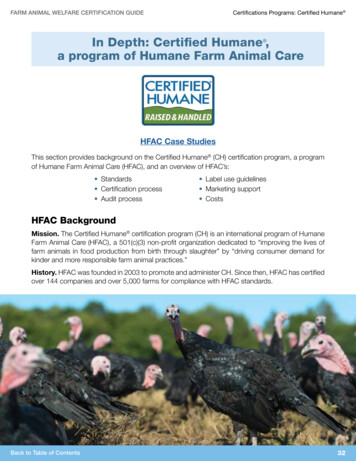
Transcription
FARM ANIMAL WELFARE CERTIFICATION GUIDE Certifications Programs: Certified Humane In Depth: Certified Humane ,a program of Humane Farm Animal Care HFAC Case StudiesThis section provides background on the Certified Humane (CH) certification program, a programof Humane Farm Animal Care (HFAC), and an overview of HFAC’s: Standards Certification process Audit process Label use guidelines Marketing support CostsHFAC BackgroundMission. The Certified Humane certification program (CH) is an international program of HumaneFarm Animal Care (HFAC), a 501(c)(3) non-profit organization dedicated to “improving the lives offarm animals in food production from birth through slaughter” by “driving consumer demand forkinder and more responsible farm animal practices.”History. HFAC was founded in 2003 to promote and administer CH. Since then, HFAC has certifiedover 144 companies and over 5,000 farms for compliance with HFAC standards.Back to Table of Contents32
FARM ANIMAL WELFARE CERTIFICATION GUIDE Certifications Programs: Certified Humane For a Range of Farm Businesses. HFAC certifies single operations, producer groups, beefmarketing groups and its own category of “pooled product operations” – entities that (1) buyproducts from individual production operations that have been inspected by HFAC and foundto be in conformance with HFAC standards (but are not certified individually), and (2) sell thepooled product under the PPO’s name. Additionally, HFAC certifies “Product ManufacturingOperations” (PMOs) – entities producing products that include animal-based raw materials fromHFAC-certified operations. Restaurants may apply to be certified as PMOs, as well.Standards. HFAC’s standards cover birth through slaughter and are driven by HFAC’s philosophythat “animals must be free to do what comes naturally.” Accordingly, HFAC states, “chickens mustbe able to flap their wings and dust-bathe, and pigs must have the space to move around androot.” Likewise, cages, crates and tie stalls are prohibited, and animals must be fed a diet of“quality feed, without animal by-products, antibiotics or growth hormones.” Finally, “producersmust comply with food safety and environmental regulations,” and “livestock processors mustcomply with the American Meat Institute (AMI) guidelines, a slaughter standard written by Dr.Temple Grandin, a member of HFAC’s Scientific Committee.” Poultry producers must comply with thePoultry Slaughter Standards written by the HFAC Scientific Committee.Animals covered. HFAC’s standards cover the following animals: BisonBeef and dairy cowsBroiler chickensLaying hens Dairy, fiber and meat goatsPigsDairy, fiber and meat sheepTurkeysWhere Sold. Relative to AWA and GAP, products with CH’s Certified Humane Raised and Handled label are sold by the widest variety of distributors, retailers and restaurants. They can be found in theUnited States, Brazil, Canada, Chile and Peru. To search for CH products, visit certifiedhumane.org/shop.Looking Forward. HFAC states that, in 2003, the CH program covered approximately 143,000farm animals, and that, today, it covers over 100 million. According to HFAC, they are unlikely tocover other animal species in the near future. Rather, they are focused on continuing to promote theexisting program, including its newer “Free Range” and “Pasture Raised” labels.Back to Table of Contents33
FARM ANIMAL WELFARE CERTIFICATION GUIDE Certifications Programs: Certified Humane HFAC STANDARDSEach certification program covered in this guide requires compliance with standards coveringvarious aspects of farm animal husbandry. Below is an overview of how HFAC develops itsstandards; which stages of life its standards cover; and HFAC’s record-keeping requirements. Toreview all HFAC standards, visit click here.Standards DevelopmentHFAC states that it developed its standards in conjunction with a “40 member ScientificCommittee.comprised of animal scientists and veterinarians from the United States, Canada,Europe, and South America.” Typically, according to HFAC, proposals for new or modifiedstandards originate within this committee. However, HFAC staff, operators and other interestedparties may also generate new or modified standards for review by the committee.After the Scientific Committee agrees on the text of a new or revised standard, HFAC distributesthe draft to producers potentially impacted by the proposed standard for their comments. HFAC’sStandards Committee compiles comments from this “public comment” period, incorporates othercomments from the Scientific Committee, considers the proposed standards and then presentsfinal recommendations to the HFAC Board of Directors, which makes the final decision on whetherto adopt the recommendations or make no change.Stages of Life CoveredHFAC’s standards cover “birth through death.” They focus on feed and water, environment, animalmanagement, health, transportation and slaughter. In addition, HFAC does traceability audits on allproducts to ensure they’re coming from HFAC-certified producers and animals.Record-Keeping RequirementsHFAC’s record-keeping standards are in place to allow auditors to review what has occurred on thefarm in between audits and vary slightly across species. However, HFAC generally requires:A FARM PLAN REGARDING:A RECORD OF: Training program for caretakers Animal health and care of sick/injuredanimals Emergency procedures (for fire, flood,interruption of food, water, electricity,etc.) Animal feed provided Dated production data (alterations,castration, temperature, ammonialevels, etc.) Building features (total floor area, maxcapacity, etc.) Quarantine procedures and use ofmedication All incoming and outgoing animals,including transport records ComplaintsBack to Table of Contents34
FARM ANIMAL WELFARE CERTIFICATION GUIDE Certifications Programs: Certified Humane Most of HFAC’s record-keeping requirements include things many farmers will already be doing,such as recording the dates of physical procedures (castration, etc.), tracking medication use,and noting all animal sales or transfers. In addition to providing a record for auditors to review,record-keeping helps producers spot trends on their farms and operate their businesseseffectively by measuring key outcomes. HFAC does not require records to be kept in any specificway. Farmers are welcome to keep their records the old-fashioned way, putting pen to paper innotebooks, logs or calendars. Similarly, HFAC accepts Excel sheets and Word documents.Note: Standards Deviation RequestsIf you believe you are complying with the spirit of a standard, but achieving that result throughpractices different than the standard specifies, you may contact HFAC and request a deviation.The relevant species subcommittee of the Standards Committee will determine whether or not topermit it.Back to Table of Contents35
FARM ANIMAL WELFARE CERTIFICATION GUIDE Certifications Programs: Certified Humane HFAC CERTIFICATION PROCESSHFAC certifies farms, producer groups, beef marketing groups, product manufacturing operations(including restaurants) and “pooled product operations,” described above. The certification processdescribed below applies to individual farms. Information about the certification process forProducer Groups, Pooled Product Operations (PPOs), and Product Manufacturing Operations canbe found on the following pages, and in further detail in the HFAC Policy Manual.STEP ONESTEP TWOReview HFAC Standards & PoliciesSubmit Application Read the HFAC standards for the species youwish to certify and the HFAC Policy Manual toconfirm your farm will comply with relevantstandards and policies. Review the application process and submit anapplication form and a 75 application fee toHFAC. Confirm that your slaughter facilities areagreeable to being inspected for compliance byan HFAC auditor. Note: HFAC treats your business informationas confidential.STEP THREESTEP FOURSchedule & Facilitate an InspectionObtain Certification & Use Label After you apply, HFAC will undertake an InitialReview of your application to evaluate whetheryour operation is capable of complying withHFAC standards. HFAC will make a certification determination. If your application satisfies the Initial Review, anHFAC inspector will contact you to schedule andconduct an inspection (audit). To learn moreabout the inspection process, including costs,click here. Note: HFAC treats observations and informationcollected during the course of the inspection asconfidential. Approved operations will be provided aCertification Mark License Agreement governinglabel use. The certification fee will follow the HFAC FeeSchedule. Certification is valid for 1 year. Note: You may appeal a certification decision orenter a dispute resolution process for otherprogram concerns.STEP FIVERecertification & Changes to Certification HFAC-certified businesses must renew their certification annually by submitting a completed application formand application fee. The renewal process begins about 60 days before a business’ certification expires, andincludes generally the same steps as the initial certification. You must notify HFAC if you change the types or amounts of products certified or you make significantchanges to your management or organizational structure. You must withhold products produced under thechanged procedures until HFAC has reviewed the changes (possibly resulting in an Amended Certificate ofCertification). Note: Your certification may be suspended or revoked for nonconformances, as set forth in theHFAC Policy Manual.Back to Table of Contents36
FARM ANIMAL WELFARE CERTIFICATION GUIDE Certifications Programs: Certified Humane HFAC CERTIFICATION PROCESSFOR PRODUCERS GROUPSThe certification process described below applies to Producer Groups, which are defined as a“close-knit group of producers that uses similar production practices, markets their products incommon, and is managed by an Internal Control System (ICS). The ICS is the system used by theProducer Group to provide oversight of the group’s activities and conformance with certificationstandards. The ICS inspects production operations, monitors minor nonconformances and keepsrecords for the group.HFAC requires that producers seeking certification as a Producer Group must: Use uniform farming practices that reflect a consistent process or methodologyProduce similar productsBe managed under one central, uniform and consistent administrationEstablish and implement their own system of internal control, supervision and documentationof producer practices to ensure conformance with HFAC certification standards Maintain an education program to ensure that all members understand the applicablecertification standards and how they apply to their specific operations Utilize central processing, manufacturing, distribution and marketing facilities Maintain an operator complaints logWhen a Producer Group applies for certification, HFAC determines whether it will conduct 100% ofthe audits or whether the Group’s Internal Control System may instead provide information to HFACto evaluate conformance with HFAC standards and procedures. HFAC may choose to rely on theICS for a portion of inspections if it determines that the ICS’s records mirror HFAC’s own findingsand the ICS: Inspects all producers at least annually Inspects all new producers before including them in the Producer Group Performs inspections in a manner rigorous enough for HFAC to use the resulting findings todetermine conformance with HFAC’s standards Appropriately address any instances of nonconformance Maintains adequate records of its inspections Assists producers in understanding and conforming with HFAC’s standardsThe ICS must be established and functional before HFAC will accept the Producer Group. If HFACdetermines that the ICS can carry out its own inspections, the ICS must complete its inspectionsand send all records and documentation to HFAC according to a predetermined schedule. HFACwill conduct annual inspections of the ICS and at least 10% of the Producer Group’s farmers toensure compliance, with inspection fees of 800 per day per inspector.Back to Table of Contents37
FARM ANIMAL WELFARE CERTIFICATION GUIDE Certifications Programs: Certified Humane Producer Group inspections have three main components – assessments done in the ICS office,assessments done in the field and any activities done to conclude the inspection. Assessments inthe office focus on evaluating the Producer Group’s ICS to ensure that all management systemsare fully implemented and to review producer files for accuracy and completeness. Assessmentsdone in the field focus on inspecting some of the group’s farms and comparing those results withthe results of the ICS’s inspection of the same operation. The inspection concludes with an ExitInterview, where the inspector discusses any nonconformances and presents a summary of theaudit activities and findings to the managers of the Producer Group. The inspector submits his/herfindings to HFAC in a written Inspection Report. From there, the certification process mirrors that offarmers, with a certification determination and annual recertification audits.HFAC CERTIFICATION PROCESS FORPOOLED PRODUCT OPERATIONSThe certification process described below applies to Pooled Product Operations (PPOs) thatbuy products from individual producers that have been inspected by HFAC and found to be inconformance with HFAC standards. PPOs are not certified individually, but they sell productunder the PPO’s name. PPOs pay HFAC for the inspections of the producers from which they buyproducts and pay the certification fees for the pooled product that is being sold as CertifiedHumane under the PPO’s name.The certification process generally mirrors that of farmers, with an initial review of standards,submission of application (including the 75 fee), scheduled audit ( 800 fee), certificationdetermination and annual recertification audits. The PPO submits its own application along withthe individual application for each of the producers participating in the pool. If all of the PPO’sdocuments are turned in together, the PPO pays a single application fee and pays the audit feesfor all of the producers being inspected. PPOs are responsible for maintaining an audit trail of allcertified products contributing to the pool and their sale, handling and processing. HFAC inspectsPPO processing/slaughter facilities annually to confirm that there has been no co-mingling ofcertified and non-certified product during processing. Notification of the certification determinationis sent to the PPO, along with copies of the inspection reports for the individual farms and anynecessary corrective actions forms.Back to Table of Contents38
FARM ANIMAL WELFARE CERTIFICATION GUIDE Certifications Programs: Certified Humane HFAC CERTIFICATION PROCESS FORPRODUCT MANUFACTURING OPERATIONS(AND RESTAURANTS)The certification process described below applies to Product Manufacturing Operations (PMOs)looking to sell products using Certified Humane ingredients and bearing the Certified Humane logo. PMOs are entities producing products that include ingredients or raw materials from HFACcertified operations.EXAMPLES OF PRODUCT MANUFACTURING OPERATIONSAnimal BasedRaw MaterialsRaw MilkEggs in the ShellWhole Meat CarcassProduct ManufacturingOperationDairy ProcessorEgg ProcessorFood ProcessorManufacturedProducts Pasteurized whole milkSkim milkCreamDry milk powderIce cream (multi-ingredient) Bulk liquid eggsEgg whitesPowdered eggsBaked goods containing eggs(multi-ingredient) Cut & packaged fresh meatJerky sticksPre-cooked chicken chunksCanned meat in meat brothVegetable beef stew(multi-ingredient)Raw Animal HideTannery Leather Leather shoes(multi-ingredient) Leather furniture coversWool FleeceWool Mill Cleaned fleece Wool yarn Wool sweater (multi-ingredient)Back to Table of Contents39
FARM ANIMAL WELFARE CERTIFICATION GUIDE Certifications Programs: Certified Humane Certified Humane requires food manufacturers to be audited to ensure that all the ingredients goinginto the product are coming from Certified Humane producers. The certification process generallymirrors that of farmers, with an initial review of standards, submission of application (including the 75 fee), scheduled audit ( 800 fee), certification determination and annual recertification audits.HFAC determines PMO certification by reviewing each product to ensure the PMO: Has a sourcing plan to ensure that all the animal-based ingredients are produced byHFAC-certified operations Ensures sufficient product identification and segregation of HFAC-certified ingredients duringstorage, handling, and/or manufacturing Keeps sufficient records to show conformance with HFAC standards for:– Sourcing ingredients,– Product segregation, and– Complaints to operators. (Must maintain a complaints log) Has product label(s) that conform to HFAC’s label and seal use regulationsBack to Table of Contents40
FARM ANIMAL WELFARE CERTIFICATION GUIDE Certifications Programs: Certified Humane HFAC INSPECTION PROCESSStep 1Step 2Step 3FacilitiesAnimalsRecordsHFAC employees conduct audits, which it calls “inspections,” to assess and potentially certify youroperation’s conformance with HFAC standards and policies. HFAC inspects processes, facilities,animals and records.When Are Inspections Required? Initially: HFAC conducts an inspection as part of the initial application process. Annually: After certification, HFAC conducts inspections annually as a part of the certificationrenewal process. Unannounced: HFAC may perform unannounced inspections in order to assess an operation’scontinued conformance with HFAC standards and policies.– Unannounced inspections are performed using the same procedures as routine inspectionsexcept that the inspector does not contact the operator about the inspection more than 24hours prior to arrival at the certified operation.– Inspectors are permitted to perform unannounced inspections without any prior notice to theoperator, but, according to HFAC, some notice is normally given to ensure that the neededpersonnel can participate. For Program Assessment: Periodically, HFAC selects random member farms to audit (alsounannounced) in order to assess the effectiveness and consistency of the HFAC auditingprogram, as well as the performance of its auditors. Random audits may cover a full farm or justa particular species or management practice.Who Conducts Inspections? Generally: HFAC contracts with approximately 30 inspectors. In creating a plan for the inspection,HFAC first determines which aspects of your business need to be inspected and then determineswho from the HFAC list of inspectors is most qualified to conduct the inspection. Background & Training: All of HFAC’s inspectors are required to either have a Masters or Ph.D. inanimal science or a veterinary degree. Additionally, each inspector has expertise in a specificspecies. All inspectors participate in an inspection-training program. After the initial training, eachauditor is accompanied by a more experienced auditor during at least his or her first two audits.After the apprentice inspections, the experienced inspectors evaluate the new inspectors todetermine whether or not the new inspector needs additional training.Back to Table of Contents41
FARM ANIMAL WELFARE CERTIFICATION GUIDE Certifications Programs: Certified Humane Impartiality: HFAC states that it seeks to ensure that the chosen inspector has not been involvedin (or employed by a business or person involved in) the design, supply, installation or maintenanceof products related to your operation within 24 months of the inspection. All inspectors fill out adeclaration of interest form so that HFAC can ensure they are not inspecting an entity with whichthey have a relationship. If you object to the use of a particular inspector, you may contact theDirector of Certification to explain the objection. At HFAC’s discretion, another inspector may beassigned.What Happens During an Inspection?The inspection process varies somewhat depending on the type of entity being inspected.However, it generally involves the following steps. (For information about the inspection andcertification process for specific kinds of business entities, review the HFAC Policy Manual Part 3.)Pre-audit: Off-farm Activity First contact. An HFAC inspector will contact you to schedule the inspection visit. Theinspector will explain and answer questions about the inspection process.Audit Part 1: On-farm Activity Discussion. The inspector will meet with you to discuss the inspection schedule and procedures.Next, the inspector will meet with farm managers and employees to discuss their roles andresponsibilities and determine their knowledge of HFAC requirements. Observation of Procedures, Facilities, Animals. The inspector will observe the proceduresyou use to manage and care for the farm animals in order to determine the level of conformancewith HFAC standards and policies. Observed practices and procedures include animalnutrition and animal condition, housing, sourcing stock, animal identification methods, husbandrypractices, handling systems, implementation of animal health plans, availability of emergencyaction plans, management of casualty animals and the general environment of the operation. Review of Records. The inspector reviews records listed on page 34; documents referencedon the Application for Certification; records related to tracing animals; records documentingthe products used in the management of your operation; and information provided byveterinarians, feed suppliers and other parties who provide goods and services to your farm. Exit Interview. At the end of the inspection, the inspector will meet with you to summarize theinspection findings and provide you with an overview of the observed nonconformances, ifany. During this meeting you have the opportunity to provide corrections, clarifications, andadditional information. Overall Length. The length of the inspection varies depending on the size and complexity ofthe operation, but average between a half day and full day.Back to Table of Contents42
FARM ANIMAL WELFARE CERTIFICATION GUIDE Certifications Programs: Certified Humane Audit Part 2: Slaughter FacilityHFAC will inspect your slaughter facility to ensure it is compliant with HFAC standards. If it is not,either the slaughter facility must make the necessary changes to become compliant, or you willhave to use another compliant slaughter plant in order to become certified. For livestock, HFACrequires that producers applying to the program have their animals slaughtered at facilitiesthat meet American Meat Institute (AMI) guidelines. For poultry, HFAC requires that producersapplying to the program have their animals slaughtered at facilities that meet the Poultry SlaughterStandards written by HFAC’s scientific committee, which include: Slaughtering birds within four hours of arrival at the plant and within 12 hours of feedwithdrawal on farm Ensuring that birds are not suspended for more than 90 seconds before they are stunned Ensuring at least 90 seconds have elapsed post-slaughter before putting birds in thescalding tankPost-Audit: Follow-Up & Corrective Action Determination. After the inspections, the inspector compiles an inspection report. Basedon that report, HFAC makes one of three written certification determinations:1) Your operation complies with all relevant HFAC policies and standards and is awardedcertification;2) Your operation has one or more “minor nonconformance” with the relevant HFAC standardsand policies, and must make the required corrections within a 30-day period;3) Your operation has one or more “major nonconformance” with the relevant HFAC standardsand policies, and is therefore denied certification. Conditional Certification. An operation is granted “Conditional Certification” if it has one ormore minor nonconformance with HFAC standards and policies. During the Initial CertificationProcess, HFAC may issue a “Certificate of Conditional Certification” to allow an operation withone or more “minor nonconformance” to use the HFAC seal while it is undertaking correctiveactions. If operations with conditional certification do not correct “minor nonconformances”within 30 days, they are denied certification. Denial. If your farm is denied certification, you must wait six months before reapplying.Additional Inspection InformationFor additional information on the HFAC inspection process, review HFAC Policy Manual Part 3,including the following charts:Back to Table of ContentsInitial Certification Process FlowchartPart 2, DRenewal of Certification Process FlowchartPart 2, E43
FARM ANIMAL WELFARE CERTIFICATION GUIDE Certifications Programs: Certified Humane HFAC LABEL USE GUIDELINESLicense Agreement. HFAC controls ownership, use and display of its certification mark throughthe Certification Mark License Agreement. This Agreement describes HFAC’s legal rights to addressincorrect references to the certification system or misleading use of licenses, certificates or marksfound in advertisements. The Agreement also requires members to supply HFAC with samples oftheir packaging, advertising or promotional materials bearing the HFAC mark upon HFAC’s request.HFAC’s Certification Mark License Agreement is not publicly available. For questions on label topicsnot covered here, contact HFAC directly.USDA-FSIS Label Approval. As described in the USDA-FSIS Labeling section, prior to use ofthe Certified Humane Raised and Handled label, approval by the United States Department ofAgriculture (USDA) Food Safety & Inspection Service (FSIS) is required.Back to Table of Contents44
FARM ANIMAL WELFARE CERTIFICATION GUIDE Certifications Programs: Certified Humane HFAC MARKETING SUPPORTAccording to HFAC, the program provides the following marketing support to its members: Internet Visibility. According to HFAC, the CH website averages over 12,000 unique visitorsa month. The website directs visitors to where they can buy products with the CertifiedHumane Raised and Handled label, lists CH-certified producers and profiles CH farmers. Social Media. New products and producers are posted on the HFAC Facebook , Instagram and Twitter pages. HFAC also distributes a monthly newsletter with readership in the thousandswhich highlights special products, new farm stories and world news. Downloadable Free App. This app lists stores that sell products with the Certified HumaneRaised and Handled label, as well as which products are in each store. HFAC standards, alist of CH-certified producers, FAQs, a media kit and a donation platform are also available onthe app for easy access for farmers. Press Releases. HFAC issues press releases for all new producers that successfully completethe Certified Humane certification process. Sourcing Outreach. HFAC actively works with supermarkets and other retailers to find buyersfor CH-certified products. Promotion by Welfare Organizations. HFAC claims that over 70 “humane organizations”promote its program on their websites, in their publications and in targeted direct mailings,reaching national audiences. Media Visibility. HFAC highlights that numerous publications have profiled the CH programand directed readers to where to find products with the Certified Humane Raised andHandled label.HFAC COSTSAs set forth below, HFAC has annual application, inspection and certification fees. For some qualified“small operations,” HFAC partially or fully subsidizes inspection costs.Annual Application & Inspection FeesApplication for Initial Certification 75Application for Renewal Certification Fee (annual) 75Inspection Fee: FarmInspection Fee: Processor, Product ManufacturingOperation, Pooled Product Operation, Slaughterand Handling Facility 700/day/inspectorBack to Table of Contents 800/day/inspector45
FARM ANIMAL WELFARE CERTIFICATION GUIDE Certifications Programs: Certified Humane Annual Certification FeesHFAC’s certification fees are based on the amount of product processed and the number of animalsor animal products sold because they are certified, not because there is a label on the package.Certification fees are generally paid on a monthly basis, but small operations may be allowed topre-arrange quarterly payments at the discretion of HFAC’s Executive Director.CERTIFICATION FEESCattle0-25,000 animals25,001-50,000 animals50,001-75,000 animals75,001-100,000 animals100,001-200,000 animals200,001-300,000 animals300,001-400,000 animals 1.10/head 0.82/head 0.62/head 0.47/head 0.37/head 0.22/head 0.07/headPigs0-35,000 animals35,001-65,000 animals65,001-100,000 animals100,001-200,000 animals 200,000 animals 0.55/pig 0.45/pig 0.35/pig 0.25/pig 0.15/pigDairy CowsHundredweight of milk 0.015 (1/8th cent/gallon)GoatsFor milkFor meat 0.008/gallon 0.23/headCase of 30 dozen eggs 0.071-6,000,000 birds6,000,001-15,000,000 birds15,000,001-30,000,000 birds 30,000,000 birds 0.003/lb 0.0025/bird 0.002/bird 0.0015/birdSheep/LambPer headPer gallon 0.23 0.008TurkeysPer pound 0.0023YoungDairy BeefPer head 0.55Bison0-500 animals501-2500 animals 2500 animals 1.00/head 0.75/head 0.50/headLaying HensBroilerChickensUsed with permission from HFACBack to Table of Contents46
FARM ANIMAL WELFARE CERTIFICATION GUIDE Certifications Programs: Certified Humane Subsidies for “small operations.” Upon request, HFAC may partially or fully subsidize the costsof inspections for qualified “small operations.”SIZE OF OPERATIONS ELIGIBLE FOR SUBSIDIZED INSPECTION FEESSpecies covered by thecertificate applicationNumber of animals being certifiedis not greater than:Beef Cattle50 headBroilers100 headDairy30 headGoats50 headLayers100 headPigs50 headSheep70 headTurkeys70 headYoung Dairy Beef30 headUsed with permission from HFACTransition Costs.
FARM ANIMAL WELFARE CERTIFICATION GUIDE Certifications Programs: Certified Humane Back to Table of Contents Most of HFAC's record-keeping requirements include things many farmers will already be doing, such as recording the dates of physical procedures (castration, etc.), tracking medication use, and noting all animal sales or transfers.


